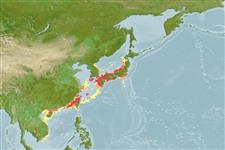Environment: milieu / climate zone / depth range / distribution range
Écologie
marin démersal. Subtropical
Western Pacific: Japan to the Philippines.
Taille / Poids / Âge
Maturity: Lm ? range ? - ? cm
Max length : 12.2 cm SL mâle / non sexé; (Ref. 33416)
Description synthétique
Clés d'identification | Morphologie | Morphométrie
Épines dorsales (Total) : 9; Rayons mous dorsaux (Total) : 12; Épines anales: 3; Rayons mous anaux: 12. Lateral line scales 27, plus 1 on the base of caudal fin; nearly always 13 pectoral rays (rarely 14), females without dark caudal spot; longest dorsal soft ray ranges from 1.95-2.3 in HL (Ref. 33416).
Life cycle and mating behavior
Maturities | Reproduction | Spawnings | Egg(s) | Fecundities | Larves
Randall, J.E., 1999. Halichoeres bleekeri (Steindachner & Döderlein), a valid Japanese species of labrid fish, distinct from H. tenuispinis (Günther) from China. Ichthyol. Res. 46(3):225-231. (Ref. 33416)
Statut dans la liste rouge de l'IUCN (Ref. 130435)
Menace pour l'homme
Harmless
Utilisations par l'homme
Outils
Articles particuliers
Télécharger en XML
Sources Internet
Estimates based on models
Preferred temperature (Ref.
123201): 16.1 - 27.1, mean 22 °C (based on 84 cells).
Phylogenetic diversity index (Ref.
82804): PD
50 = 0.5000 [Uniqueness, from 0.5 = low to 2.0 = high].
Bayesian length-weight: a=0.00955 (0.00451 - 0.02020), b=3.09 (2.92 - 3.26), in cm total length, based on LWR estimates for this Genus-body shape (Ref.
93245).
Niveau trophique (Ref.
69278): 3.4 ±0.5 se; based on size and trophs of closest relatives
Résilience (Ref.
120179): Haut, temps minimum de doublement de population inférieur à 15 mois (Preliminary K or Fecundity.).
Fishing Vulnerability (Ref.
59153): Low vulnerability (10 of 100).
